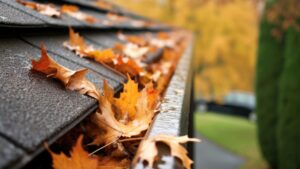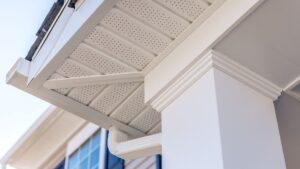When your asphalt shingles shed some of their granules, should you be concerned? If a pile of granules awaits you when you walk out the front door because of last night’s rainstorm, what caused that? Is it normal? And can it be avoided?
Read on to uncover the cause of granule loss and when to contact a professional roofer for a roof inspection.
The Purpose of Your Roof’s Granules
Granules are the exterior coating on asphalt roofing shingles and they add an extra element of protection to your roof. They keep the two underlying layers of your roofing shingles—the asphalt and fiberglass mat—from being exposed to the weather.
Asphalt shingle granules also help keep rain, snow, and ice from collecting on your roof and protect it from the effects of harmful UV rays. And they provide a layer of fire protection to your home, delivering another safety element to you, your loved ones, and your possessions.
What Causes Granule Loss?
It’s no mystery what causes your roof to lose granules. Some of the common causes include:
1. The age of your roof
The age of your roof is the most direct cause of granule loss. Granules are bonded to your roof shingles by the asphalt. When the bond ages, it also weakens; as a result, all kinds of wear ant damage can pull the granules loose. You may find them in your gutters, in your yard, or at the base of your downspout.
2. Improper roof installation
When roofing professionals cut corners, significant granule loss can be the result. If your roof is shedding shingle granules from poor installation techniques, you may have other hidden issues, such as moisture penetration. And problems like water infiltration can worsen and cause costly repairs or roof replacement if left unaddressed.
3. Severe weather
Since granules protect your home from storms, you may notice that harsh weather, wind-driven rain or hailstorms naturally loosen a few granules here and there.
Over time, however, extreme temperatures and harsh weather can weaken your roof granules’ bond, causing them to detach in larger amounts. If you find lots of granules in your yard or gutters after a severe storm, do a thorough visual inspection of your home. Ensure there are no bald spots on your roof.
If you’ve had excessive granule loss or other evidence of damage, contact a reputable roofer promptly to do an inspection and minimize the possibility of any further damage.
4. Poor-quality roofing materials
Subpar roofing materials can lose their shingle granules quickly. If you see small bubbles or blisters on your roofing shingles along with granule loss, manufacturing defects are likely the culprit. If poor-quality materials caused your granules to turn loose, it’s time for a roof inspection. You may need a replacement to safeguard your home from damage.
5. New roof shingles
It’s normal to lose some shingle granules after you get a roof replacement. When a new asphalt roof is installed, roofers loosen granules naturally as they handle, cut, and nail your shingles to your home. Don’t be alarmed if you see a few granules in your gutters immediately after the first storm following your roof installation. It’s normal, and it will pass.
6. The climate in your area
The climate in which you live will play a direct part in how long your granules will stay intact and how long your current roof will last. If your granule loss is extensive, and your roof is up in years, you’ll likely need to replace it.
What Happens When Your Roof Loses Too Many Granules?
If your roof is aging and you notice excessive granule loss, contact a roofer and have it inspected promptly. Because shingle granules deliver weatherproof protection for your home, it’s more vulnerable to the elements without them.
Here are some of the results of granule loss:
You may observe discolored or exposed areas on your roof
After severe storms, take a walk around your home and visually check your roof. Grab some binoculars and step away from your property to look more carefully.
If you spot a lack of uniformity in your roofing’s color, a patchy look, a bald spot, or damaged-looking shingles, it’s time to call a roofing professional and have your roof inspected.
Your roof’s lifespan may decrease
Granules contribute to weatherproofing your home. Without an adequate number of them, the effects of your roof’s exposure to the elements 24/7 will speed up your roof’s deterioration.
You may need to replace your roof
Your roof’s age and granule loss will determine whether you need to repair or replace it. If your roof is more than 20 years old and you have a lot of granule loss when it storms, you should have it inspected by a reputable team of roofing professionals (like us!).
How to Avoid Significant Granule Loss

At Best Choice Roofing, we only install Owens-Corning, the finest roofing shingles on the market, ensuring you get the best long-term performance out of your investment.
When we inspect your current roof, we provide photo and video evidence of any discovered damages and issues so you know exactly what is going on with your roof.
Learn more about our roofing services.



